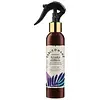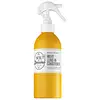What's inside
What's inside
 Key Ingredients
Key Ingredients

 Benefits
Benefits

 Concerns
Concerns

 Ingredients Side-by-side
Ingredients Side-by-side

Water
Skin ConditioningAloe Barbadensis Leaf Juice
Skin ConditioningPropanediol
SolventGlycerin
HumectantCetearyl Alcohol
EmollientPhyllanthus Emblica Fruit Extract
HumectantHydrolyzed Quinoa
Skin ConditioningHydrolyzed Adansonia Digitata Seed Extract
Hibiscus Sabdariffa Flower Extract
Skin ConditioningPhenoxyethanol
PreservativeBenzyl Alcohol
PerfumingCaprylic/Capric Triglyceride
MaskingParfum
MaskingCoconut Alkanes
EmollientCetyl Alcohol
EmollientOlealkonium Chloride
Behentrimonium Methosulfate
Behentrimonium Chloride
PreservativeVp/Va Copolymer
Xylitol
HumectantSalvia Hispanica Seed Extract
EmollientTrehalose
HumectantCaprylyl/Capryl Glucoside
CleansingCarthamus Tinctorius Seed Oil
MaskingEthyl Linoleate
EmollientIsopropyl Alcohol
SolventCoco-Caprylate/Caprate
EmollientEthyl Oleate
EmollientSorbitan Oleate
EmulsifyingPolyquaternium-37
Alcohol Denat.
AntimicrobialPolyquaternium-11
Stearamine Oxide
CleansingCaprylic/Capric Glycerides Polyglyceryl-10 Esters
EmollientGuar Hydroxypropyltrimonium Chloride
Skin ConditioningMyristyl Alcohol
EmollientStearyl Alcohol
EmollientSodium Phosphate
BufferingPolyquaternium-7
Caprylic Acid
CleansingOleamidopropyl Dimethylamine
Potassium Sorbate
PreservativeSodium Benzoate
MaskingAlcohol
AntimicrobialLaurtrimonium Chloride
EmulsifyingSodium Bisulfite
AntioxidantPentaerythrityl Tetra-Di-T-Butyl Hydroxyhydrocinnamate
AntioxidantTocopherol
AntioxidantBenzyl Salicylate
PerfumingLimonene
PerfumingHydroxycitronellal
PerfumingCitronellol
PerfumingWater, Aloe Barbadensis Leaf Juice, Propanediol, Glycerin, Cetearyl Alcohol, Phyllanthus Emblica Fruit Extract, Hydrolyzed Quinoa, Hydrolyzed Adansonia Digitata Seed Extract, Hibiscus Sabdariffa Flower Extract, Phenoxyethanol, Benzyl Alcohol, Caprylic/Capric Triglyceride, Parfum, Coconut Alkanes, Cetyl Alcohol, Olealkonium Chloride, Behentrimonium Methosulfate, Behentrimonium Chloride, Vp/Va Copolymer, Xylitol, Salvia Hispanica Seed Extract, Trehalose, Caprylyl/Capryl Glucoside, Carthamus Tinctorius Seed Oil, Ethyl Linoleate, Isopropyl Alcohol, Coco-Caprylate/Caprate, Ethyl Oleate, Sorbitan Oleate, Polyquaternium-37, Alcohol Denat., Polyquaternium-11, Stearamine Oxide, Caprylic/Capric Glycerides Polyglyceryl-10 Esters, Guar Hydroxypropyltrimonium Chloride, Myristyl Alcohol, Stearyl Alcohol, Sodium Phosphate, Polyquaternium-7, Caprylic Acid, Oleamidopropyl Dimethylamine, Potassium Sorbate, Sodium Benzoate, Alcohol, Laurtrimonium Chloride, Sodium Bisulfite, Pentaerythrityl Tetra-Di-T-Butyl Hydroxyhydrocinnamate, Tocopherol, Benzyl Salicylate, Limonene, Hydroxycitronellal, Citronellol
Water
Skin ConditioningGlycerin
HumectantParfum
MaskingStearyl Alcohol
EmollientCoconut Alkanes
EmollientCocoglucosides Hydroxypropyltrimonium Chloride
CleansingCetyl Alcohol
EmollientBehentrimonium Methosulfate
Bertholletia Excelsa Seed Oil
EmollientTheobroma Grandiflorum Seed Butter
Skin ConditioningOrbignya Oleifera Seed Oil
EmollientAstrocaryum Tucuma Seed Butter
EmollientTocopherol
AntioxidantCoco-Caprylate/Caprate
EmollientLactic Acid
BufferingGardenia Jasminoides Fruit Extract
Cosmetic ColorantHydrolyzed Gardenia Florida Extract
AntioxidantButylene Glycol
HumectantMaltodextrin
AbsorbentPhenoxyethanol
PreservativeIsohexadecane
EmollientSodium Hydroxide
BufferingLimonene
PerfumingBenzyl Alcohol
PerfumingCoumarin
PerfumingBenzyl Salicylate
PerfumingHydroxycitronellal
PerfumingWater, Glycerin, Parfum, Stearyl Alcohol, Coconut Alkanes, Cocoglucosides Hydroxypropyltrimonium Chloride, Cetyl Alcohol, Behentrimonium Methosulfate, Bertholletia Excelsa Seed Oil, Theobroma Grandiflorum Seed Butter, Orbignya Oleifera Seed Oil, Astrocaryum Tucuma Seed Butter, Tocopherol, Coco-Caprylate/Caprate, Lactic Acid, Gardenia Jasminoides Fruit Extract, Hydrolyzed Gardenia Florida Extract, Butylene Glycol, Maltodextrin, Phenoxyethanol, Isohexadecane, Sodium Hydroxide, Limonene, Benzyl Alcohol, Coumarin, Benzyl Salicylate, Hydroxycitronellal
 Reviews
Reviews

Ingredients Explained
These ingredients are found in both products.
Ingredients higher up in an ingredient list are typically present in a larger amount.
Behentrimonium Methosulfate is an ammonium salt. It is mainly used to prevent static in haircare products as a surfactant.
Surfactants have differing ends: one side is hydrophilic while the other end is hydrophobic.
Surfactants also help your cleansers remove pollutants more easily from the skin.
Learn more about Behentrimonium MethosulfateBenzyl Alcohol is most commonly used as a preservative. It also has a subtle, sweet smell. Small amounts of Benzyl Alcohol is not irritating and safe to use in skincare products. Most Benzyl Alcohol is derived from fruits such as apricots.
Benzyl Alcohol has both antibacterial and antioxidant properties. These properties help lengthen the shelf life of products. Benzyl Alcohol is a solvent and helps dissolve other ingredients. It can also improve the texture and spreadability.
Alcohol comes in many different forms. Different types of alcohol will have different effects on skin. This ingredient is an astringent alcohol.
Using high concentrations of these alcohols are drying on the skin. They may strip away your skin's natural oils and even damage your skin barrier. Astringent alcohols may also irritate skin.
Other types of astringent alcohols include:
According to the National Rosacea Society based in the US, you should be mindful of products with these alcohols in the top half of ingredients.
Any type of sanitizing product will have high amounts of alcohol to help kill bacteria and viruses.
Learn more about Benzyl AlcoholBenzyl Salicylate is a solvent and fragrance additive. It is an ester of benzyl alcohol and salicylic acid. This ingredient can be naturally found in some plants and plant extracts.
In fragrances, Benzyl Salicylate may be a solvent or a fragrance component. In synthetic musk scents, it is used as a solvent. For floral fragrances such as lilac and jasmine, it is used as a fragrance component. The natural scent of Benzyl Salicylate is described as "lightly-sweet, slightly balsamic".
While Benzyl Salicylate has been associated with contact dermatitis and allergies, emerging studies show it may not be caused by this ingredient alone.
However, this ingredient is often used with fragrances and other components that may cause allergies. It is still listed as a known allergen in the EU. We recommend speaking with a professional if you have concerns.
Another study from 2021 shows Benzyl Salicylate may have anti-inflammatory properties.
Learn more about Benzyl SalicylateCetyl Alcohol is a fatty alcohol. Fatty Alcohols are most often used as an emollient or to thicken a product.
Its main roles are:
Though it has "alcohol" in the name, it is not related to denatured alcohol or ethyl alcohol.
The FDA allows products labeled "alcohol-free" to have fatty alcohols.
Learn more about Cetyl AlcoholCoco-Caprylate/Caprate is created from fatty coconut alcohol, caprylic acid, and capric acid.
It is a lightweight emollient. Emollients create a thin barrier on the skin to trap moisture in. This helps keep your skin hydrated and soft.
Once applied, Coco-Caprylate/Caprate is absorbed quickly and leaves a silky feel.
Coco-Caprylate/Caprate may not be fungal acne safe.
Learn more about Coco-Caprylate/CaprateCoconut Alkanes is created from the fatty-acids of coconut oil. It is volatile, meaning it evaporates from the skin.
This ingredient is an emollient and solvent. As an emollient, it helps keep skin soft and hydrated. Solvents help distribute and mix other ingredients. This ensures a more even consistency.
Coconut Alkanes may not be fungal-acne safe.
Learn more about Coconut AlkanesGlycerin is already naturally found in your skin. It helps moisturize and protect your skin.
A study from 2016 found glycerin to be more effective as a humectant than AHAs and hyaluronic acid.
As a humectant, it helps the skin stay hydrated by pulling moisture to your skin. The low molecular weight of glycerin allows it to pull moisture into the deeper layers of your skin.
Hydrated skin improves your skin barrier; Your skin barrier helps protect against irritants and bacteria.
Glycerin has also been found to have antimicrobial and antiviral properties. Due to these properties, glycerin is often used in wound and burn treatments.
In cosmetics, glycerin is usually derived from plants such as soybean or palm. However, it can also be sourced from animals, such as tallow or animal fat.
This ingredient is organic, colorless, odorless, and non-toxic.
Glycerin is the name for this ingredient in American English. British English uses Glycerol/Glycerine.
Learn more about GlycerinHydroxycitronellal is a fragrance created from citronellal. The smell of hydroxycitronellal is often described as "citrus-like" or "melon-like".
Hydroxycitronellal is a known EU allergen and may cause irritation when applied to the skin.
Limonene is a fragrance that adds scent and taste to a formulation.
It's found in the peel oil of citrus fruits and other plants such as lavender and eucalyptus. The scent of limonene is generally described as "sweet citrus".
Limonene acts as an antioxidant, meaning it helps neutralize free radicals.
When exposed to air, oxidized limonene may sensitize the skin. Because of this, limonene is often avoided by people with sensitive skin.
The term 'fragrance' is not regulated in many countries. In many cases, it is up to the brand to define this term. For instance, many brands choose to label themselves as "fragrance-free" because they are not using synthetic fragrances. However, their products may still contain ingredients such as essential oils that are considered a fragrance.
Learn more about LimoneneParfum is a catch-all term for an ingredient or more that is used to give a scent to products.
Also called "fragrance", this ingredient can be a blend of hundreds of chemicals or plant oils. This means every product with "fragrance" or "parfum" in the ingredients list is a different mixture.
For instance, Habanolide is a proprietary trade name for a specific aroma chemical. When used as a fragrance ingredient in cosmetics, most aroma chemicals fall under the broad labeling category of “FRAGRANCE” or “PARFUM” according to EU and US regulations.
The term 'parfum' or 'fragrance' is not regulated in many countries. In many cases, it is up to the brand to define this term.
For instance, many brands choose to label themselves as "fragrance-free" because they are not using synthetic fragrances. However, their products may still contain ingredients such as essential oils that are considered a fragrance by INCI standards.
One example is Calendula flower extract. Calendula is an essential oil that still imparts a scent or 'fragrance'.
Depending on the blend, the ingredients in the mixture can cause allergies and sensitivities on the skin. Some ingredients that are known EU allergens include linalool and citronellol.
Parfum can also be used to mask or cover an unpleasant scent.
The bottom line is: not all fragrances/parfum/ingredients are created equally. If you are worried about fragrances, we recommend taking a closer look at an ingredient. And of course, we always recommend speaking with a professional.
Learn more about ParfumPhenoxyethanol is a preservative that has germicide, antimicrobial, and aromatic properties. Studies show that phenoxyethanol can prevent microbial growth. By itself, it has a scent that is similar to that of a rose.
It's often used in formulations along with Caprylyl Glycol to preserve the shelf life of products.
Stearyl Alcohol is a type of fatty alcohol from stearic acid. It is a white, waxy compound used to emulsify ingredients.
Fatty Alcohols are most often used as an emollient or to thicken a product. Emollients help soothe and hydrate the skin by trapping moisture.
They are usually derived from natural fats and oils and therefore do not have the same drying or irritating effect as solvent alcohols. FDA allows products labeled "alcohol-free" to have fatty alcohols.
Learn more about Stearyl AlcoholTocopherol (also known as Vitamin E) is a common antioxidant used to help protect the skin from free-radicals and strengthen the skin barrier. It's also fat soluble - this means our skin is great at absorbing it.
Vitamin E also helps keep your natural skin lipids healthy. Your lipid skin barrier naturally consists of lipids, ceramides, and fatty acids. Vitamin E offers extra protection for your skin’s lipid barrier, keeping your skin healthy and nourished.
Another benefit is a bit of UV protection. Vitamin E helps reduce the damage caused by UVB rays. (It should not replace your sunscreen). Combining it with Vitamin C can decrease sunburned cells and hyperpigmentation after UV exposure.
You might have noticed Vitamin E + C often paired together. This is because it is great at stabilizing Vitamin C. Using the two together helps increase the effectiveness of both ingredients.
There are often claims that Vitamin E can reduce/prevent scarring, but these claims haven't been confirmed by scientific research.
Learn more about TocopherolWater. It's the most common cosmetic ingredient of all. You'll usually see it at the top of ingredient lists, meaning that it makes up the largest part of the product.
So why is it so popular? Water most often acts as a solvent - this means that it helps dissolve other ingredients into the formulation.
You'll also recognize water as that liquid we all need to stay alive. If you see this, drink a glass of water. Stay hydrated!
Learn more about Water